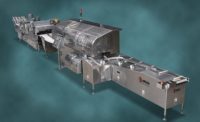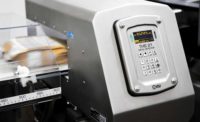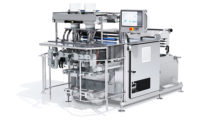The latest bagging and closing equipment—performing everything from bagging and tying to heat-sealing—is flexible and able to produce a variety of bag styles. Also, modular machine designs allow for layout flexibility and scalability, which lets producers expand their production capacity.
From a trends perspective, manufacturers see a growing demand for consumer-friendly, stand-up bags using a stronger type of layered film. These bags can stand upright without assistance, which enhances shelf differentiation. The exact sealing technology required for these bag styles is dictated by the producer, whose decision is often based on the product inside of the bag.
“We see a trend toward bags with recloseable features, such as Aplix, zippers and pressure-sensitive labels,” says Paul Wilson, vice president of sales and marketing, Rovema North America, Norcross, GA. “While the technology has been around for many years, the use of these applications is increasing. Another common request is for flexible bagging machines that can produce a variety of styles. There also seems to be a shift away from premade bags toward flexibles and gas-tight packaging.”
To tie, clip or seal
What are the benefits of tie/clip versus reseal? “The obvious advantage of the twist tie is the ease of reclosing the bag and the tightness of the closure,” says Mitch Lindsey, technical sales, Burford Corp., Maysville, OK. “The disadvantage of resealing is not having anything to close the end of the bag with, and possible damage to the bag when left inside the sealer too long—or if it is not set correctly.”
The tie/clip close is very simple, but in the absence of a hermetic seal, packages cannot maintain modified atmosphere for best shelf life. “The clock on a resealable hermetic package only starts ticking once opened for the first time,” says Cem Yildirim, market development sales manager, Multivac Inc., Kansas City, MO. “Also, hermetically sealed and resealable packages have a built-in tamper-evident feature.”
A zipper reseal feature ensures that a package is securely closed to seal in freshness and prevent food spillage, says Art Malcomson, director of sales, Zip Pak, an ITW Co., Manteno, IL. “Zip-Pak applicators integrate with many different types of packaging machines, ensuring that the application is efficient. Also, having the zipper sealed to the package ensures that it cannot detach during downstream processes.”
One of the biggest challenges inherent in designing closing equipment for select types of baked goods and snacks is temperature control in manufacturing facilities. Creating a zipper that can handle the transition from a warm environment to a frozen environment requires expertise in material application for both the zipper and film to which it is attached.
How is return on investment different for these methods? Malcomson says that a reliable reseal is a packaging feature likely to motivate food shoppers to select one product over another. “The addition of a high-quality zipper to flexible packaging gives brand owners an opportunity to increase sales and product share in their respective categories.”
However, adding reclosability features to a package will result in higher material costs, says Kelly Meer, product manager, Bosch Packaging Technology Inc., New Richmond, WI. “For both options, bakery/snack producers need to evaluate if the consumer is willing to pay a higher price and if adding these features will help increase sales. In many cases, additional steps in the packaging process are required to apply a reclosability feature, which may impact overall line effectiveness.”
Equipment innovations
Among a host of introductions in the area of bagging and closing equipment, Zip Pak recently introduced the 360 tdi Series, a compact transverse zipper applicator for vertical form/fill/seal and bag conversion machines. The applicator reportedly is capable of running narrow or wide flange zippers, is compact and space-saving, and allows for fast operation and accurate registration.
Formost Fuji Corp., Woodinville, WA, has developed Premium Bread Wrapper with Pass Through Technology, which simplifies production while providing an alternative on the same wrapper for bread that does not require overwrap. “The overwrap feature lengthens the shelf life and maintains freshness of the product. Not only does this reduce footprint space, it also reduces costly maintenance of a typical overwrap,” says Angela McDaniel, marketing and sales coordinator.
Burford Corp. has upgraded its existing twist tie machines to help run at the higher speeds requested by customers. “We have upgraded the software and made a few mechanical changes to accommodate faster line speeds. And dependent on a few variables—conveyor speed, flight spacing, bag size—these changes can help customers achieve speeds up to 100 PPM (packages per minute),” Lindsey says.
Multivac Inc. has developed the Multivac Tray Carrier system for its T300 tray sealer to handle difficult-shaped trays, as well as the R081 small-footprint thermoformer. “Both machines enable bakery/snack producers to increase production capacity within a smaller footprint. The T300 and the R081 are capable of evacuation and gas flushing, which helps bakery/snack products reach their optimal shelf life,” Yildirim says.
Bosch Packaging has introduced two complete packaging systems for sweet and savory biscuits that can be easily adapted to changing market needs, producing slug and pile packs. Their modular designs allow for layout flexibility and scalability, letting producers incrementally expand production capacity and increase the level of automation—from entry level, hand-fed machines, to fully automated solutions.
The new Apache CM (continuous motion) bagger from Bosch Packaging/Kliklok-Woodman, Atlanta, is a high-speed machine based on a hypocycloidal drive, which provides extended end seal dwell times at high speeds. The machine is suitable for miniature snack cake, as well as cereal packaging applications.
Rovema North America has introduce a Premiumseal system for use with its SBS bagging machines, which reportedly offers higher seal strength and improved tightness. “It also allows adjustment of the seal pressure force curve, saves on energy consumption during the seal process, and offers more material choices. The system not only permits sealing through thicker films, but it adds to shelf life by providing a secure and stable seal,” Wilson says.
The ultrasonic option
Ultrasonic sealing offers great potential—but with a more-targeted approach due to the products in the bags that it seals, according to Meer. He notes ultrasonic sealing is suited to more thermo-sensitive, fresh products, including chocolate. “The technology uses friction, via mechanical oscillation, generated between two film layers to create enough temperature to seal the bag at the precise location, reducing product waste. Because this process requires no heated tooling, it eliminates thermal influences on products.”
Bosch Packaging offers a variety of sealing technologies for its vertical form/fill/seal machines, which includes polyethylene, heat and ultrasonic sealing. The choice of sealing technology, however, is ultimately determined by the type of product being packaged and the composition of the packaging material, Meer notes.
Ultrasonic sealing of thin films and other ultrasonic packaging solutions continue to evolve with the ever-changing packaging industry, according to Steve Bellavia, business unit director, packaging, Herrmann Ultrasonics, Bartlett, IL. “We see more exciting projects that conventional heat-seal technology cannot deliver on. This involves new materials and packages that require a different method of heat generation.
“For example,” continues Bellavia, “a package that is very thick may not allow enough heat to transfer from the outside of the material to the inside. However, the molecular friction that the ultrasonic vibration induces will likely be able to create the necessary heat.”
In addition, the ultrasonic process offers advances in real-time process control feedback. For example, the high-precision distance measurement feature on the Herrmann Ultrasonics Top Seal Module provides even more process control, sensing pouch thickness variations as small as 1 micron, Bellavia notes.
High on the priority list of many snack producers and bakers is the drive to decrease overall material usage and package size. “Many are discovering that ultrasonic sealing solutions can contribute to this initiative. Ultrasonics can create high quality and repeatable hermetic seals, even if product contamination is present in the seal area,” Bellavia adds.
Looking ahead, manufacturers of bagging and closing equipment see more technological advances in the near future—advances that may benefit snack and bakery plants. Use of more programmable logic controllers (PLCs) will aid in troubleshooting and give food processors control from remote locations. Also, web-connected packaging equipment will have a major impact on data collection and real-time analysis, thus improving efficiency.
“The promising work being done with rotary ultrasonic sealing technology could offer increased production speeds,” Malcomson says. “In terms of zipper technology, Zip-Pak recently added a Sensus family of products that offer consumers enhanced audial and tactile feedback to ensure that packages are properly closed.”
At the end of the day, satisfaction with the performance of a product’s packaging can make a significant contribution toward repeat purchase.










